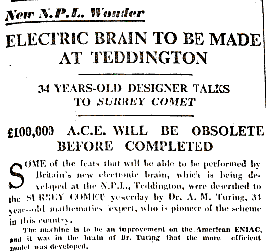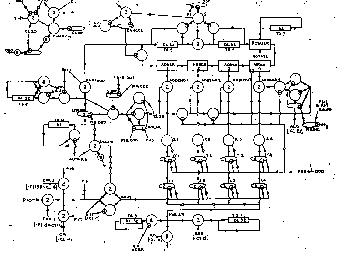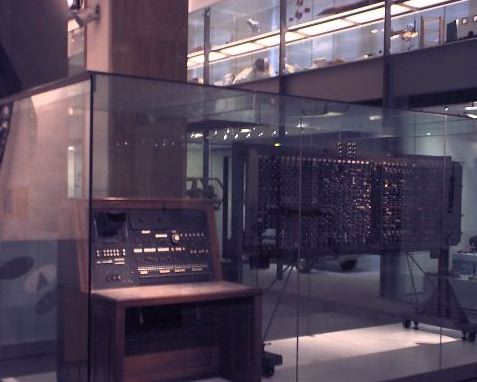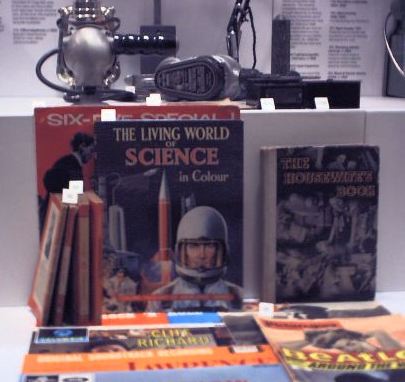 |
 |
Alan Turing's own computer design
In the previous Scrapbook page you will find a discussion of 'Who Invented the Computer?' My answer is that Alan Turing did. It was Alan Turing who first saw the principle of the Universal Machine and its practicability for implementation in electronics. That's because he based his ideas on what he had seen in 1936 — the concept of the universal machine. (See this Scrapbook Page). In the abstract universal machine of 1936 the programs were written on the store in just the same way as the data and the working. This was no coincidence. Turing's discoveries in mathematical logic, using the Turing machine concept, depended on seeing that programs operating on numbers could themselves be represented as numbers.
But Turing's 1945 conception of the computer was not tied to numbers at all. It was for the logical manipulation of symbols of any kind. From the start he stressed that a universal machine could switch at a moment's notice from arithmetic to the algebra of group theory, to chess playing, or to data processing.
Von Neumann was in the business of calculating for the atomic bomb and for artillery tables, concerned with doing massive amounts of arithmetic. Alan Turing came fresh from codebreaking, work on symbols which wasn't necessarily to do with arithmetic. He had seen a vast establishment built up with special machines organised to do different tasks. Now, Turing saw, they could all be replaced by programs for a single machine. Further, he saw immediately the first ideas of programming structure and languages.
What's more, he had taught himself electronics and organised an electronic cryptographic project himself so that he had hands-on experience of digital technology. (See this Scrapbook Page) He did not want to be only a theoretician, but to see his ideas coming to life in practice.
So why isn't Alan Turing famous as the inventor of the computer?
History is on the side of the winner, and Alan Turing was a loser in the race to build the first electronic computer. More broadly, British science and engineering, with its early lead, was bound to be eclipsed by the power of American industry and commerce.
But In 1945 Alan Turing could have felt like a winner. He was taken on by the National Physical Laboratory at Teddington, in London suburbs. His detailed plan for an electronic computer, with a visionary prospectus for its capacities, was accepted in March 1946. Everything seemed to be going for it.
Well, not quite everything. Turing's plan called for at least 6k bytes of storage, in modern terms, and this was considered far too ambitious.
And the Colossus electronic engineers, now returned to the Post Office, were unable to make a quick start on the plan as he had expected.
Even so, in late 1946 the NPL put out press releases which made it perfectly clear that Turing's design was seen as a major national project and an outstanding example of British innovation.
|
 |
Some of the feats that will be able to be performed by Britain's new electronic brain, which is being developed at the N.P.L., Teddington, were described to the SURREY COMET yesterday by Dr. A. M. Turing, 34-year-old mathematics expert, who is the pioneer of the scheme in this country. The machine is to be an improvement on the American ENIAC, and it was in the brain of Dr Turing that the more efficient model was developed....
From the local suburban newspaper, the Surrey Comet, 9 November 1946. More text in my book.
|
|
|
But it was not to be. The rigid style of management meant that nothing was built in 1947 or 1948 and virtually all his ideas from this period, including the beginnings of a programming language, were lost when he resigned from the NPL in 1948. Another factor was that the complete secrecy about the codebreaking operations meant that Turing could never draw on his immense and successful experience, instead appearing as a purely theoretical university mathematician.
Furthermore, he did not promote his ideas effectively. If he had written papers on The Theory and Practice of Computing in 1947, instead of going on to new ideas, he would have done more for his reputation.
He didn't. He went running and he thought about what he saw as the next step: Artificial Intelligence. Or rather, it was for him not so much the next step, as the very thing which made him interested in computers at all. The very idea of the Turing machine in 1936 drew upon modelling the action of the mind.
 |
The Runner Up
Alan Turing got very depressed and angry about the NPL, and losing a race against time. But he eased his frustration by becoming a world class distance runner.
Go to this Scrapbook Page to see the marathon man.
|
After 1948 almost everyone forgot that he had drawn up the design for a computer in 1945-6, the most detailed design then in existence. The mathematician M. H. A. (Max) Newman, when writing his Biographical Memoir of Turing in 1955, passed over this period with the words,
...many circumstances combined to turn his interest to the new automatic computing machines. They were in principle realizations of [Turing's] 'universal machine'... though their designers did not yet know of Turing's work.
How could Newman have forgotten that Turing himself was such a designer — in fact the author of the very first detailed design — and that obviously he knew of his own work?
Alan Turing's reputation has been subject to a strange kind of selective memory. Now, the computer itself can help put matters right before your eyes.

A page of detailed electronic design from Turing's ACE report
|
Newman entirely neglected Turing's origination of the computer, and this has done considerable harm to Turing's subsequent reputation in computer science. But his neglect reflects a pure mathematician's attitude which perhaps holds a deeper truth. Newman's Biographical Memoir lamented the fact that Turing was taken away from the mathematics he was doing in 1938-39, his deepest work. He saw the computer as a comparatively trivial offshoot, and a diversion from what Turing should have done.
After Turing resigned, a change in management at the NPL meant that the ACE project could go ahead after all. A working computer, based on his original design, was operating in 1950. It was called the Pilot ACE, reflecting the fact that it was a scaled-down version of Turing's original vision.
|
The future of the ACE
Since 1958, the 1950 Pilot ACE has been exhibited at the Science Museum, London.
In 2012-13 it became the centrepiece of a special centenary exhibition devoted to Turing's life and work. It is on permanent display.
After nearly 50 years of public exhibition, it is hard to know why Alan Turing's computer design has remained so unknown.
These are my own 2002 snapshots.
The ACE exhibit is splendidly set in a story-line of twentieth century history.
On its left is a towering V2 rocket, captured from the world of 1945 in which Turing's design was conceived.
But on its right is an artfully arranged collection representing the 1960 world in which digital electronic computing took off.
The display captures the 1960 imagery of science as a Boys Own business, with phallic rockets and space-helmets set in contrast to 'The Housewife's Book'. But underneath them you see the emergent rock-and-pop world, a sign of how much the civilian world would change by the end of the 1960s.
No-one would have guessed in 1960 that in 2000 computer sales would be booming through the development of the Internet, used largely for sex and music.
|  |
 |
Alan Turing and the Internet
Alan Turing proposed in his 1946 report that it would be possible to use the ACE computer by a remote user over a telephone link. So he foresaw the combination of computing and telecommunications long before others. One of Turing's early colleagues at the NPL, Donald W. Davies, went on to pioneer the principle of packet switching and so the development of the ARPANET which led to the Internet you are using now.
|
|
Alan Turing moved to Manchester in 1948, having despaired of the NPL's management of his project. The argument about who was first with the idea of the computer continues there...
| 
Continue to
the next Scrapbook page.
|
|
|